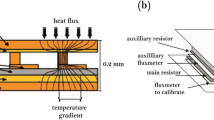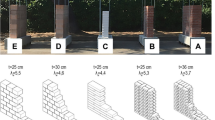Abstract
Frictional force between concrete slab and base is accompanied by horizontal slab movements induced by the variation of temperature and moisture in concrete slabs. The frictional force acts in opposite direction of the horizontal slab movement and develops stress in the slab. Rational evaluations of frictional force between slab and base are significant for designs of joint sealing, slab thickness, and reinforced steel in concrete pavement. Characteristics of friction between concrete slab and base are studied, and a reasonable model for the determination of friction between concrete slab and base are proposed.
Similar content being viewed by others
References
Friberg B. F. (1954). “Frictional Resistance under Concrete pavements and Restraint Stresses in Long Reinforced Slabs”Highway Research Board Proceedings of the 23 rd Annual Meeting, pp. 167–182 Washington D.C.
Goldbeck, A.T. (1924). “Friction Tests of Concrete on Various Subbases”,Public Roads Vol. 5, No. 5, pp. 19–21.
Jones, G. M., Darter, M. I. and Littlefield, G. (1968). “Thermal Expansion-Contraction of Asphalt Concrete”,Proceeding of the Association of Asphalt Paving Technology, Vol. 37 Feb, pp. 56–95.
Kragelski, I. V., Dobychin M. N. and Kombalov, V.S. (1977). “Friction and Wear: Calculation Methods”, Pregamon Press.
Lee, L. H. and Ludema, K. C. (1981). “Friction and Wear of Polymers”,Tribology Series 6, Elsevier.
Lee, S. W. (2000). “Horizontal Joint Movements in Rigid Pavements”,Ph.D. Thesis, the Pennsylvania State University
McCullough, B. F. and Mondoza A. (1985). “Report on a Mechanistic Analysis of the PCC Airport Aprons at King Fahd International Airport”, Kingdom of Saudi Arabia, Austin Research Engineers.
Pittman D. W. and McCullough B. F. (1997). “Development of a Roller-Compacted Concrete Pavement Crack and Joint Spacing Model”,Transportation Research Record No. 1567, Transportation Research Board, pp. 52–64.
Stott, J. P. (1963). “Tests on Materials for use in Sliding Layers under Concrete Road Slabs”,Civil Engineering, Vol. 56, No. 663, pp. 1297–1301, pp. 1466–1468, pp. 1603–1605.
Teller L. W. and Bosley, H. L. (1936). “The Arlington Curing Experiments”, Public Roads Vol. 16, No. 9, pp. 169–197.
Teller L. W. and Sutherland, E. C. (1930). “The Structural Design of Concrete Pavements”,Public Roads Vol. 10, No. 12, pp. 213–230.
Timms, A. G. (1963). “Evaluating Subgrade Friction-Reducing Mediums for Rigid Pavements”, Highway Research Record No. 60,Highway research Board, pp. 28–38, Washington D.C.
Wesevich, J. W., McCullough, B. F. and Burns, N. H. (1987). “Stabilization Subbase Study for Concrete Pavement”,Research Report 459-1, Center for Transportation Research, University of Texas at Austin.
Author information
Authors and Affiliations
Corresponding author
Additional information
The manuscript for this paper was submitted for review on September 19, 2000.
Rights and permissions
About this article
Cite this article
Lee, S.W. Characteristics of friction between concrete slab and base. KSCE J Civ Eng 4, 265–275 (2000). https://doi.org/10.1007/BF02823975
Issue Date:
DOI: https://doi.org/10.1007/BF02823975




